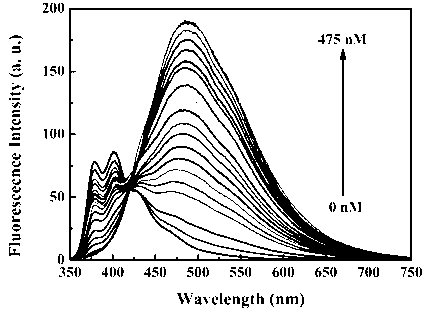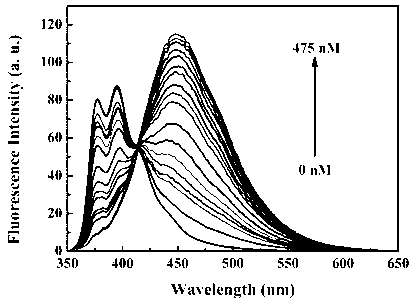Fluorescent probe: benzothiazole-terpyridine compound used for distinguishing and detecting zinc ions and cadmium ions, preparation method and application method thereof
A technology of benzothiazole and terpyridine, applied in the chemical field, can solve problems such as the inability to effectively distinguish between zinc ions and cadmium ions, and limit the practical application of fluorescent probes, and achieve the effect of simple preparation process and wide application prospects
- Summary
- Abstract
- Description
- Claims
- Application Information
AI Technical Summary
Problems solved by technology
Method used
Image
Examples
Embodiment 1
[0035] Example 1: Synthesis of fluorescent probe 4-(4-benzothiazolylphenyl)ethynyl terpyridine.
[0036] (1) Synthesis of 2-(4-bromophenyl)benzothiazole
[0037]Add 0.46g (2.5mmol) p-bromobenzaldehyde and 0.31g (2.5mmol) o-aminothiophenol into 25mL triethyl phosphate, stir for 10min, add 2.5mL glacial acetic acid, stir rapidly and heat up to 60°C, add 1.8g (3.75mmol) lead tetraacetate, stirred for 30 minutes, cooled to room temperature, added 100mL water and 50mL dichloromethane, separated, collected the organic phase, extracted the aqueous layer with dichloromethane three times (50mL×3), collected and combined The organic phase was dried with anhydrous magnesium sulfate, the solvent was evaporated to dryness, and the obtained solid was separated and purified by 100-200 mesh silica gel column chromatography (dichloromethane: petroleum ether = 1:2) to obtain the product 2-(4-bromobenzene Base) benzothiazole 0.46g, yield 63%. Its melting point was measured to be 137.2°C.
[0...
Embodiment 2
[0048] Example 2: The response of the fluorescence spectrum of the fluorescent probe 4-(4-benzothiazolylphenyl)ethynyl terpyridine (compound I) to zinc ions and cadmium ions.
[0049] Prepare an aqueous solution with a zinc ion and cadmium ion concentration of 25-450nM, take 5mL of zinc ion and cadmium ion aqueous solutions of different concentrations and 5mL of aqueous solutions without zinc ion and cadmium ion, and add 1×10 -4 M compound I in acetonitrile solution 50 μL, after shaking evenly, test its fluorescence spectrum. The test conditions are: excitation wavelength 375nm, slit width 2.5nm / 2.5nm, voltage 700V. Test results such as figure 1 (containing zinc ions) and figure 2 (Contains cadmium ions).
[0050] from figure 1 It can be clearly found that in the aqueous solution without zinc ions, the fluorescence emission peaks of compound I are split peaks, which are respectively located at 380nm and 400nm. When the concentration of zinc ions in the solution is lower ...
Embodiment 3
[0053] Example 3: The fluorescence spectrum of the fluorescent probe 4-(4-benzothiazolylphenyl)ethynyl terpyridine (compound I) responds to zinc ions and cadmium ions in the presence of interfering ions.
[0054] Ni with a concentration of 0.25 μM was respectively configured 2+ , Ca 2+ , Mg 2+ 、Al 3+ , Zn 2+ 、K + , Pb 2+ 、Co 2+ 、Cd 2+ 、Cr 2+ 、Cu 2+ and Na + Ionic aqueous solution, and each 5mL was added to it with a concentration of 2.5×10 -5 M compound I in acetonitrile solution 50 μL, after shaking evenly, test its fluorescence spectrum. The test conditions are: excitation wavelength 375nm, slit width 2.5nm / 2.5nm, voltage 700V. Test results such as image 3 with Figure 4 shown.
[0055] from image 3 It can be seen that when the solution does not contain zinc ions, the fluorescence intensity of the probe does not change significantly before and after adding various common metal cations in the aqueous solution. When the concentration of zinc ions in the solu...
PUM
| Property | Measurement | Unit |
|---|---|---|
| melting point | aaaaa | aaaaa |
| melting point | aaaaa | aaaaa |
Abstract
Description
Claims
Application Information
 Login to View More
Login to View More - R&D
- Intellectual Property
- Life Sciences
- Materials
- Tech Scout
- Unparalleled Data Quality
- Higher Quality Content
- 60% Fewer Hallucinations
Browse by: Latest US Patents, China's latest patents, Technical Efficacy Thesaurus, Application Domain, Technology Topic, Popular Technical Reports.
© 2025 PatSnap. All rights reserved.Legal|Privacy policy|Modern Slavery Act Transparency Statement|Sitemap|About US| Contact US: help@patsnap.com



